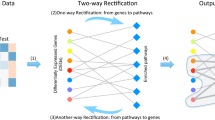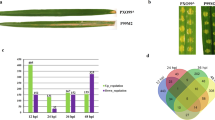Abstract
Identification of differentially expressed genes (DEGs) in time course studies is very useful for understanding gene function, and can help determine key genes during specific stages of plant development. A few existing methods focus on the detection of DEGs within a single biological group, enabling to study temporal changes in gene expression. To utilize a rapidly increasing amount of single-group time-series expression data, we propose a two-step method that integrates the temporal characteristics of time-series data to obtain a B-spline curve fit. Firstly, a flat gene filter based on the Ljung–Box test is used to filter out flat genes. Then, a B-spline model is used to identify DEGs. For use in biological experiments, these DEGs should be screened, to determine their biological importance. To identify high-confidence promising DEGs for specific biological processes, we propose a novel gene prioritization approach based on the partner evaluation principle. This novel gene prioritization approach utilizes existing co-expression information to rank DEGs that are likely to be involved in a specific biological process/condition. The proposed method is validated on the Arabidopsis thaliana seed germination dataset and on the rice anther development expression dataset.
Similar content being viewed by others
References
Dudoit S, Yang Y H, Callow M J, Speed T P. Statistical methods for identifying differentially expressed genes in replicated cDNA microarray experiments. Statistica Sinica, 2002, 12(1): 111–139
Tusher V G, Tibshirani R, Chu G. Significance analysis of microarrays applied to the ionizing radiation response. Proceedings of the National Academy of Sciences of the United States of America, 2001, 98(9): 5116–5121
Smyth G K. Limma: linear models for microarray data. In: Gentleman R, Carey V J, Huber W, et al, eds. Bioinformatics and Computational Biology Solutions Using R and Bioconductor. New York: Springer, 2005, 397–420
ElBakry O, Ahmad M O, Swamy M N. Identification of differentially expressed genes for time-course microarray data based on modified RM ANOVA. IEEE/ACMTransactions on Computational Biology and Bioinformatics, 2012, 9(2): 451–466
Bar-Joseph Z. Analyzing time series gene expression data. Bioinformatics, 2004, 20(16): 2493–2503
Ernst J, Nau G J, Bar-Joseph Z. Clustering short time series gene expression data. Bioinformatics, 2005, 21(suppl_1): 159–168
Chaiboonchoe A, Samarasinghe S, Kulasiri G D. Using emergent clustering methods to analyse short time series gene expression data from childhood leukemia treated with glucocorticoids. In: Proceedings of the 18th World IMACS Congress and MODSIM09 International Congress on Modelling and Simulation. 2009, 741–747
Bar-Joseph Z, Gerber G, Simon L, Gifford D K, Jaakkola T S. Comparing the continuous representation of time-series expression profiles to identify differentially expressed genes. Proceedings of the National Academy of Sciences of the United States of America, 2003, 100(18): 10146–10151
Conesa A, Nueda M J, Ferrer A, Talon M. maSigPro: a method to identify significantly differential expression profiles in time-course microarray experiments. Bioinformatics, 2006, 22(9): 1096–1102
Storey J D, Xiao W Z, Leek J T, Tompkins R G, Davis R W. Significance analysis of time course microarray experiments. Proceedings of the National Academy of Sciences of the United States of America, 2005, 102(36): 12837–12842
Kim J, Ogden R, Kim H. A method to identify differential expression profiles of time-course gene data with Fourier transformation. BMC Bioinformatics, 2013, 14(1): 310
Han X U, Sung W-K, Feng L I N. Identifying differentially expressed genes in time-course microarray experiment without replicate. Journal of Bioinformatics and Computational Biology, 2007, 5(02a): 281–296
Angelini C, Cutillo L, De Canditiis D, Mutarelli M, Pensky M. BATS: a Bayesian user-friendly software for analyzing time series microarray experiments. BMC Bioinformatics, 2008, 9: 415
Wu S, Wu H L. More powerful significant testing for time course gene expression data using functional principal component analysis approaches. BMC Bioinformatics, 2013, 14(1): 6
Yang EW, Girke T, Jiang T. Differential gene expression analysis using coexpression and RNA-Seq data. Bioinformatics, 2013, 29(17): 2153–2161
Pan J B, Hu S C, Wang H, Zou Q, Ji Z L. PaGeFinder: quantitative identification of spatiotemporal pattern genes. Bioinformatics, 2012, 28(11): 1544–1545
Xiao S J, Zhang C, Zou Q, Ji Z L. TiSGeD: a database for tissuespecific genes. Bioinformatics, 2010, 26(9): 1273–1275
Pan J B, Hu S C, Shi D, Cai M C, Li Y B, Zou Q, Ji Z L. PaGenBase: a pattern gene database for the global and dynamic understanding of gene function. PloS One, 2013, 8(12): E80747
Moreau Y, Tranchevent L C. Computational tools for prioritizing candidate genes: boosting disease gene discovery. Nature Reviews Genetics, 2012, 13(8): 523–536
Yu W, Wulf A, Liu T B, Khoury M J, Gwinn M. Gene Prospector: an evidence gateway for evaluating potential susceptibility genes and interacting risk factors for human diseases. BMC Bioinformatics, 2008, 9(1): 528
Chen J, Bardes E E, Aronow B J, Jegga A G. ToppGene Suite for gene list enrichment analysis and candidate gene prioritization. Nucleic Acids Research, 2009, 37(suppl_2): W305–W311
Adie E A, Adams R R, Evans K L, Porteous D J, Pickard B S. Speeding disease gene discovery by sequence based candidate prioritization. BMC Bioinformatics, 2005, 6(1): 55
Usadel B, Obayashi T, Mutwil M, Giorgi F M, Bassel G W, Tanimoto M, Chow A, Steinhauser D, Persson S, Provart N J. Co-expression tools for plant biology: opportunities for hypothesis generation and caveats. Plant Cell Environ, 2009, 32(12): 1633–1651
Obayashi T, Okamura Y, Ito S, Tadaka S, Aoki Y, Shirota M, Kinoshita K. ATTED-II in 2014: evaluation of gene coexpression in agriculturally important plants. Plant and Cell Physiology, 2014, 55(1): e6
Storey J D, Tibshirani R. Statistical significance for genome wide studies. Proceedings of the National Academy of Sciences of the United States of America, 2003, 100(16): 9440–9445
Howe E, Holton K, Nair S, Schlauch D, Sinha R, Quackenbush J. MeV: multiexperiment viewer. In: Ochs M F, Casagrande J T, Davuluri R V, eds. Biomedical Informatics for Cancer Research. Springer US, 2010, 267–277
Du Z, Zhou X, Ling Y, Zhang Z H, Su Z. agriGO: a GO analysis toolkit for the agricultural community. Nucleic Acids Research, 2010, 38(suppl_2): W64–W70
Narsai R, Law S R, Carrie C, Xu L, Whelan J. In-depth temporal transcriptome profiling reveals a crucial developmental switch with roles for RNA processing and organelle metabolism that are essential for germination in Arabidopsis. Plant Physiology, 2011, 157(3): 1342–1362
Yeung K Y, Haynor D R, Ruzzo W L. Validating clustering for gene expression data. Bioinformatics, 2001, 17(4): 309–318
Fujita M, Horiuchi Y, Ueda Y, Mizuta Y, Kubo T, Yano K, Yamaki S, Tsuda K, Nagata T, Niihama M, Kato H, Kikuchi S, Hamada K, Mochizuki T, Ishimizu T, Iwai H, Tsutsumi N, Kurata N. Rice expression atlas in reproductive development. Plant and Cell Physiology, 2010, 51(12): 2060–2081
Acknowledgments
This paper was supported by the National Natural Science Foundation of China (Grant Nos. 61271346, 61571163, 61532014, 91335112, 61671189 and 61402132).
Author information
Authors and Affiliations
Corresponding author
Additional information
Linlin Xing received his MS degree in computer science form Harbin Institute of Technology (HIT), China in 2012. He is currently a PhD candidate under the supervision of Professor Maozu Guo in the School of Computer Science and Technology, HIT. His research interests include gene expression data analysis and biological network construction.
Maozu Guo received his BS and MS degrees from Harbin Engineering University, China in 1988 and 1991 respectively, and PhD degree from Harbin Institute of Technology (HIT), China in 1998, all in computer science. He is currently a professor in the School of Computer Science and Technology, HIT. His research interests include Bioinformatics and machine learning.
Xiaoyan Liu received her BS and MS degrees in computer science from Harbin Engineering University, China, and PhD degree in Engineering Mechanics from Harbin Institute of Technology (HIT), China. She is currently an associate professor in School of Computer Science and Technology at HIT. Her research interests include Bioinformatics and knowledge-based systems.
Chunyu Wang received his BS, MS and PhD degrees in computer science from Harbin Institute of Technology (HIT), China. Now he is an associate professor in computer science and technology at HIT. His research interests include bioinformatics and machine learning.
Electronic supplementary material
Rights and permissions
About this article
Cite this article
Xing, L., Guo, M., Liu, X. et al. Identification and prioritization of differentially expressed genes for time-series gene expression data. Front. Comput. Sci. 12, 813–823 (2018). https://doi.org/10.1007/s11704-016-6287-7
Received:
Accepted:
Published:
Issue Date:
DOI: https://doi.org/10.1007/s11704-016-6287-7




